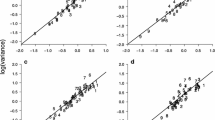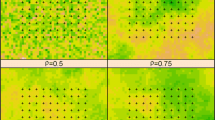Abstract
We have evaluated techniques of estimating animal density through direct counts using line transects during 1988–92 in the tropical deciduous forests of Mudumalui Sanctuary in southern India for four species of large herbivorous mammals, namely, chital (Axis axis). sambar (Cervus unicolor). Asian elephant (Elephas maximus) and gaur (Bos gaurus)
Density estimates derived from the Fourier Series and the Half-Normal models consistently had the lowest coefficient of variation. These two models also generated similar mean density estimates. For the Fourier Series estimator, appropriate cut-off widths for analyzing line transect data for the four species are suggested. Grouping data into various distance classes did not produce any appreciable differences in estimates of mean density or their variances, although model fit is generally better when data arc placed in fewer groups. The sampling effort needed to achieve a desired precision (coefficient of variation) in the density estimate is derived. A sampling effort of 800 km of transects returned a 10% coefficient of variation on estimate for ehital; for the other species a higher effort was needed to achieve this level of precision. There was no statistically significant relationship between detectability of a group and the size of the group for any species. Density estimates along roads were generally significantly different from those in the interior of the forest, indicating that road-side counts many not be appropriate for most species.
Similar content being viewed by others
References
Anderson D R, Laake J L. Crain B R and Buraham K V 1979 Guidelines for line transect sampling of biological populations;J. Wildl. Manage. 43 70–78
Barnes R E W and Jensen K L 1987 How to count elephants in forests;IUCN African Elephant and Rhino Specialist Group Technical Bulletin 1 1–6
Burnham K P, Anderson D R and Laake J L 1980 Estimation of density from line transect sampling of biological populations;Wildl. Monogr. 72 1–202
Buckland S T, Anderson D R, Burnham K P and Laake J L 1993Distance sampling: Estimating abundance of biological populations (London: Chapman and Hall)
Drummer T 1987Program dncumentation und user’s guide far SIZETRAN (Houghton, Michigan. Michigan Technological University)
Drummer T D and McDonald L L 1987 Sue bias in line transect sampling;Biometrics 43 13–21
Goodman L A 1960 On the exact variance of products;J. Am. Statist. Assioc. 708–713
Karanth K U 1988 Population structure, density and biomass of large herbivores in a south Indiantropical forest. MS dissertation. University of Florida, Gainesville, USA
Karanth K U and Sunquist M E 1992 Population structure, density and biomass of large herbivores in the tropical forests of Nagarahole, India;J. Trop, Ecol. 8 21–35
Krishnan M 1972An ecological survey of the larger mammals of peninsular India (Bombay: Bombay Natural History Society)
Koster S H and Han J A1988 Methods of estimating ungulate population in tropical forests;Afr. J. Ecol. 26 117–126
Laake J L. Burnham K P and Anderson D R 1979User manual of program TRANSECT (Logan: Ulah Stale University Press;) pp 26
Nair S S, Nair P V K. Sharaiuhandra H C and Gadgil M 1976 An ecological reconnaissance of the proposed Jawahar National Park;J. Bombay Nat. Him. Soc. 74 401–135
Sale J B, Johnsingh A J T, Dawson S 1990Preliminary trials with an indirect method of estimating Asian elephant numbers (IUCN/SSC Asian Elephant Specialist Group Report)
Sukumar R, Daltaraja H S, Suresh H S, Radhkikrishnan, J. Vasudeva R, Nirmala S and Joshi N V 1992 Long-term monitoring of vegetation in a tropical deciduous forest in Mudumalai. southern India:Curr. Sci. 62 608–616
Varman K.S 1988 A study on census of large mammals and their habitat utilization during dry season in Mudumalai Wildlife Sanctuary, M. Sc. dissertation, Bharalhidasan University. Tiruchirapalli
Varman K S and Sukumar R 1993 Ecology of sambar in Mudumalai Sanctuary, southern India; inDeer of China: Biology and management (eds) N Ohtaishi and H I Shen (Amsterdam: Elsevier Science Publishers) pp 273–284
Varman K S. Ramakrishnan U and Sukumar R1995 Direct and indirect methods of counting elephants: a comparison of results from Mudumalai mudumalai Sanctuary: inProc. International Workshop on Conservation of Asian Elephants (ed.) J C Daniel (Bombay: Bombay Natural History Society) (in press)
Author information
Authors and Affiliations
Rights and permissions
About this article
Cite this article
Varman, K.S., Sukumar, R. The line transect method for estimating densities of large mammals in a tropical deciduous forest: An evaluation of models and field experiments. J. Biosci. 20, 273–287 (1995). https://doi.org/10.1007/BF02703274
Received:
Revised:
Published:
Issue Date:
DOI: https://doi.org/10.1007/BF02703274




